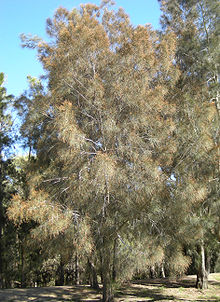| Casuarina cunninghamiana | |
|---|---|

| |
| In Mount Archer National Park | |
| Scientific classification | |
| Kingdom: | Plantae |
| Clade: | Tracheophytes |
| Clade: | Angiosperms |
| Clade: | Eudicots |
| Clade: | Rosids |
| Order: | Fagales |
| Family: | Casuarinaceae |
| Genus: | Casuarina |
| Species: | C. cunninghamiana
|
| Binomial name | |
| Casuarina cunninghamiana | |


Casuarina cunninghamiana, commonly known as river oak, river sheoak[2] or creek oak,[3] is a species of flowering plant in the family Casuarinaceae and is native to Australia and New Guinea. It is a tree with fissured and scaly bark, sometimes drooping branchlets, the leaves reduced to scales in whorls of 6 to 10, the fruit 7–14 mm (0.28–0.55 in) long containing winged seeds (samaras) 3–4 mm (0.12–0.16 in) long.
Description[edit]
Casuarina cunninghamiana is a dioecious tree that typically grows to a height of 15–35 m (49–115 ft), has a DBH of 0.5–1.5 m (1 ft 8 in – 4 ft 11 in). Its bark is finely fissured, scaly and greyish brown. The branchlets are often drooping, 100–250 mm (3.9–9.8 in) long, the leaves reduced to scale-like teeth 0.3–0.5 mm (0.012–0.020 in) long, arranged in whorls of 6 to 10 around the branchlets. The sections of branchlet between the leaf whorls (the "articles") are 4–9 mm (0.16–0.35 in) long and 0.4–0.7 mm (0.016–0.028 in) wide. The flowers on male trees are arranged in spikes 4–40 mm (0.16–1.57 in) long, the anthers 0.4–0.7 mm (0.016–0.028 in) long. The female cones are on a peduncle 2–9 mm (0.079–0.354 in) long and sparsely covered with soft hairs. Mature cones are usually 7–14 mm (0.28–0.55 in) long and 4–6 mm (0.16–0.24 in) in diameter, the samaras 3–4 mm (0.12–0.16 in) long.[2][3][4]
Taxonomy[edit]
Casuarina cunninghamiana was first formally described in 1848 by Friedrich Miquel in his book Revisio critica Casuarinarum from specimens collected by Allan Cunningham near Moreton Bay.[5] The specific epithet (cunninghamiana) honours the collector of the type specimens.[3]
In 1989, Lawrie Johnson and Alex George described subsp. miodon in the Flora of Australia, and the name, and that of the autonym are accepted by the Australian Plant Census:
- Casuarina cunninghamiana Miq. subsp. cunninghamiana[6] is a tree to 15–35 m (49–115 ft), the articles 6–9 mm (0.24–0.35 in) long with 8 to 10 teeth.[7][8]
- Casuarina cunninghamiana subsp. miodon L.A.S.Johnson[9] is a tree to 20 m (66 ft), the articles 4–7 mm (0.16–0.28 in) long with 6 or 7 teeth.[10]
Distribution and habitat[edit]
This casuarina mainly grows in pure stands in open forest on the banks of freshwater rivers and streams in Australia and New Guinea.[3][11][12]
Subspecies cunninghamiana occurs from Laura, Chillagoe and Augathella in Queensland to Condobolin and Narrandera in New South Wales, and the Australian Capital Territory.[2][3][8] Subspecies miodon occurs between the Daly River in the north of the Northern Territory to the Gulf of Carpentaria in Queensland.[10][13]
Uses[edit]
River oak is widely recognised as an important tree for stabilising riverbanks and for soil erosion prevention accepting wet and dry soils. The foliage is quite palatable to stock.[3]
Invasive species[edit]
Casuarina cunninghamiana is an invasive species in the Everglades in Florida[14] and in South Africa.[15]
References[edit]
- ^ "Casuarina cunninghamiana". Australian Plant Census. Retrieved 27 April 2023.
- ^ a b c Wilson, Karen L.; Johnson, Lawrence A.S. "Casuarina cunninghamiana". Royal Botanic Garden Sydney. Retrieved 27 April 2023.
- ^ a b c d e f Boland, Douglas J.; Brooker, M. I. H.; Chippendale, G. M.; McDonald, Maurice William (2006). Forest trees of Australia. Collingwood, Victoria: CSIRO Publishing. pp. 80–81. ISBN 0-643-06969-0.
- ^ "Casuarina cunninghamiana". Australian Biological Resources Study, Department of Agriculture, Water and the Environment: Canberra. Retrieved 27 April 2023.
- ^ "Casuarina cunninghamiana". APNI. Retrieved 27 April 2023.
- ^ "Casuarina cunninghamiana subsp. cunninghamiana". Australian Plant Census. Retrieved 27 April 2023.
- ^ Wilson, Karen L.; Johnson, Lawrence A.S. "Casuarina cunninghamiana subsp. cunninghamiana". Royal Botanic Garden Sydney. Retrieved 27 April 2023.
- ^ a b "Casuarina cunninghamiana subsp. cunninghamiana". Australian Biological Resources Study, Department of Agriculture, Water and the Environment: Canberra. Retrieved 27 April 2023.
- ^ "Casuarina cunninghamiana subsp. miodon". Australian Plant Census. Retrieved 27 April 2023.
- ^ a b "Casuarina cunninghamiana subsp. miodon". Australian Biological Resources Study, Department of Agriculture, Water and the Environment: Canberra. Retrieved 27 April 2023.
- ^ "Casuarina cunninghamiana". Plants of the World Online. Retrieved 27 April 2023.
- ^ Boxshall, Ben; Jenkyn, Tim. "River she-oak" (PDF). Department of Primary Industries. Victorian Government. Archived from the original (PDF) on 15 September 2009. Retrieved 23 April 2011.
- ^ "Casuarina cunninghamiana subsp. miodon". Northern Territory Government. Retrieved 27 April 2023.
- ^ "Biological control of Australian native Casuarina species in the USA". Commonwealth Scientific and Industrial Research Organisation. 16 May 2007. Archived from the original on 5 June 2011. Retrieved 16 September 2010.
- ^ "SANBI:Declared Weeds & Invader Plants". South African National Biodiversity Institute. Archived from the original on 6 October 2014. Retrieved 25 September 2014.